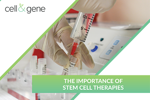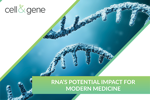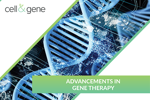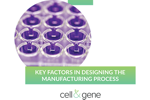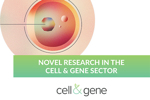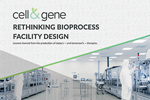CELL AND GENE CONTENT COLLECTIONS
Exclusively for subscribers of Cell & Gene, our content collections bundle articles centered around a particular topic or theme. These carefully curated selections feature content from both our internal team of editors as well as our subject matter experts who contribute regularly to the site.
-
Scaling Cell and Gene Therapies
Cell and gene therapy developers know that while there are opportunities to scale, there are also manufacturing gaps, capacity issues, and production timelines that require improvement to do so. And then, of course, there’s cost. Innovative systems such as automation, for example, may help developers to track materials through the production process, minimize labor requirements, and reduce the risk of human error. Because scale up and scale out are significant to everyone in the cell and gene sector, we’ve curated insightful editorial that addresses the most important aspects of scalability in the cell and gene therapy space.
-
Cell Therapy Outsourcing: Current Thinking, Strategies And Trends
Outsourced Pharma Chief Editor Louis Garguilo brings readers of Cell & Gene this collection of editorials on the current thinking, strategies, and trends in the cell-therapy space regarding outsourcing, and working with external partners. These editorials are based on interviews with CEOs sharing their analysis and best practices as they play out currently in their companies, and within our global industry. Garguilo covers Europe from the perspective of Miguel Forte, CEO, Bone Therapeutics, a most respected entrepreneur (MD, and professor) in the cell-therapy industry there. In the U.S., 30-year industry veteran and current CEO of Triumvira Immunologics, Paul Lammers, details an intriguing relationship his biopharma has with CDMOs, and shares his view on aspects of autologous and allogeneic therapies.
-
Autologous vs. Allogeneic CAR-T Therapies
While both allogeneic and autologous therapies use similar technologies common to the growth of cells, the scale is different. Allogeneic therapies are “off the shelf,” and are used to treat many patients (sometimes thousands). More time is available to quality control the product prior to administration. Autologous therapies are “custom” products for each patient and the chain of identity of the patient samples is critical to assure the right product is returned to the patient. Scale up of manufacturing for allogeneic cells is similar to the techniques used to make protein drugs and other large scale cell derived materials while autologous cells require scale out, the production of many individual products at the same time. We’ve curated insightful editorial that concentrates on the advancements of both allogeneic and autologous therapies and how to manufacture them at scale.
-
The Importance of Stem Cell Therapies
Academic, industry, and clinical researchers interested in stem cell biology and its therapeutic applications know that stem cell research has evolved tremendously over the last several years. The list of conditions that stem cell therapy could help treat may be endless, including conditions such as Alzheimer’s disease, heart disease, diabetes, and more. Researchers are now studying stem cells to see if they could help treat a variety of conditions that impact different body systems and parts. Here, we cover topics from stem cells in development to novel technologies in stem cell research and stem cell therapies.
-
RNA's Potential Impact for Modern Medicine
RNA therapy now has the potential to treat a wide variety of diseases, including cardiovascular disease, hemophilia, and cancer. And recent interest in RNA therapy is driven by the possibilities of better vaccines. Indeed, after a decade of painstaking progress, RNA therapies are poised to become a widely applicable approach, as research and engineering efforts have brought the field to clinical reality. Here are some of Cell & Gene’s recent and timely articles that explain not only how far RNA therapies have come, but also their inevitably safe and efficacious future for treating patients.
-
Advancements In Gene Therapy
The future is bright for gene therapy. Last year, the Nobel Prize in Chemistry was awarded to Emmanuelle Charpentier and Jennifer Doudna for pioneering CRISPR, a type of gene editing. By using genes as medicine, the industry can address the underlying cause of a disease at the cellular level, and results could potentially be achieved in just one treatment. As the industry emphasizes its commitment to rare disease patients, gene therapy is an attainable opportunity to improve the lives of patients who have complex diseases with significant unmet needs. We’re happy to share with you original, actionable editorial that illustrates the sector’s commitment to advancements in gene therapy.
-
Advancements In Cell Therapy
Cell & Gene delivers timely content on the entire life cycle of cell and gene therapies. But, as you know, even though cell therapy and gene therapy are overlapping fields of biomedical research, there are differences between them that are germane to each. Cell therapy has challenges and risks all its own, and we cover them extensively on Cell & Gene. For your reference, here are some of the latest articles that will help you better understand the benefits, risks, costs, and more associated with cell therapy.
-
Key Factors in Designing the Manufacturing Process
Ensuring scalability and efficient timelines in manufacturing while maintaining a reasonable cost is a major component of the cell and gene therapy sector in and of itself. Can the product be manufactured in the quantity and of the quality necessary to meet demand? Are your company’s process development protocols and timelines in order? Have you chosen the right facility to meet your needs, and have you invested in the best possible technology and equipment to ensure scalability? These are just some of the questions we answer for you in our collection of original editorial that caters to cell and gene therapy manufacturing processes.
-
Novel Research In The Cell And Gene Sector
The novel cell and gene therapies in the development pipeline today are the result of years of pioneering research by world-class, U.S.-based academic universities and biopharmaceutical research companies. Given the number of clinical trials in various stages, the U.S. Food and Drug Administration (FDA) expects that it will receive more than 200 investigational new drug applications a year through 2025.
-
Navigating The Cell & Gene Sector's Regulatory Landscape
Research and development of cell therapies and gene therapies continue to grow quickly, and regulatory oversight of these therapies is paramount to continued sector success. As such, Cell & Gene has published regulatory advice for sector professionals in the area of novel product development. Indeed, key regulatory tools used to enhance efficiency and expedite the review and approval of applications. For your reference, we’ve compiled this one-stop, data-rich repository of regulatory information — from challenges and the short-term outlook facing the cell and gene sector’s regulatory landscape to analyses of FDA’s recently issued guidances.
-
Outsourcing Trends For Cell & Gene Therapy
The cell and gene therapy sector’s focus on outsourcing is a major area of on-going concern due to the shortage of suitable manufacturing facilities and qualified outsourcing staff. This collection of original articles from Cell & Gene weighs the economic benefits of outsourcing (i.e. productivity, efficiency, time-to-market, and quality gains) as well as best practices for selecting an outsourcing partner. Here you’ll find information about the current limitations associated with a complicated manufacturing process as well as existing and promising opportunities and developments needed to outsource most — if not all components — of the value chain.
-
Cell and Gene Therapy Commercialization Considerations
As the cell and gene therapy landscape continues to mature, so too do the intricacies of commercialization. Inside the pages of this free collection of articles, you’ll find insightful data addressing the challenges critical for the sustainability of cell and gene therapy business models.
-
Rethinking Bioprocess Facility Design
Download this free collection of articles and learn how to let go of legacy aseptic filling line equipment, seven common filling blunders and how to avoid them, nontraditional design concepts for CAR T processing, what to do when your isolator is taking too long to de-gas. Herman and Erich Bozenhardt bring a collective 54 years of bioprocess facility design and production experience to the pages of this comprehensive ebook.




